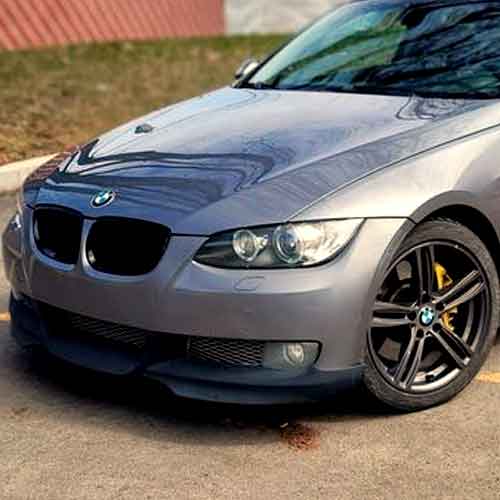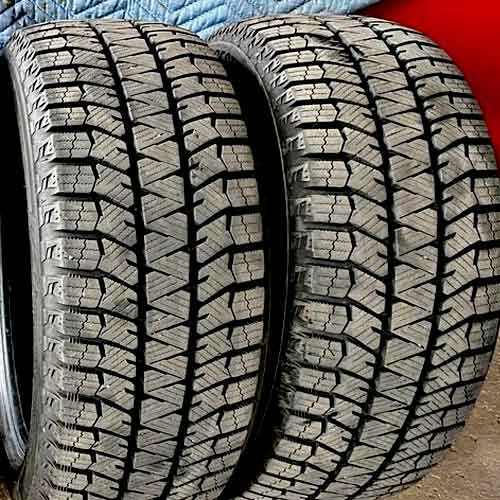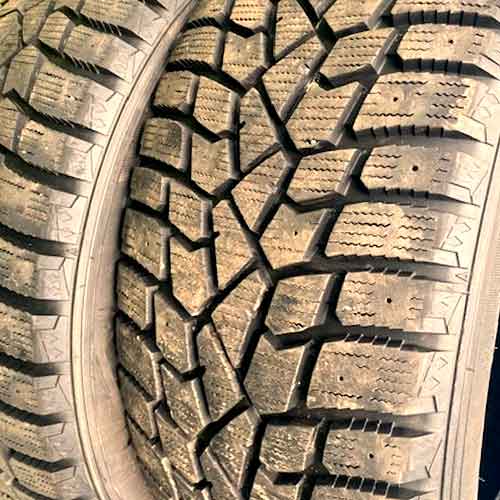In this icy standoff, Sumitomo Ice Edge, which is known for its efficient braking on snowy terrain, locks horns with the Bridgestone Blizzak WS90, revered for its superb handling on ice. Let’s check out these boys in more details.

Table of Contents
Tire Sizes
The Bridgestone Blizzak WS90 comes in 52 total sizes in 15 to 19 inches (wheels) with following specs.
- Speed ratings: T or H.
- Load ratings: SL or XL.
- Tread depth: 11 or 12/32″.
- Weight: 17 to 29 lbs.
On the other side, the Sumitomo Ice Edge comes in 14 to 20 inches with following.
- Speed ratings: T only.
- Load ratings: SL and XL.
- Tread depth: 12/32″ on all.
- Weight: 16 to 33 lbs.
Tread Appearance
The The Bridgestone Blizzak WS90 (review) is a standout with its robust and well-configured directional tread pattern. Let’s talk about it in more details.

Primarily, the tread features three prominent ribs, with the central one designed as a continuous running structure, meaning there aren’t any proper blocks there.
So this rib has a lot of things going on for it. First off, stating the obvious, it gets to have a lot of wave like siping on itself.
Moreover, you also see lateral slits, which gets thicker towards the edges and join up with the V shaped outer notches. These notches/biters face on both side, providing traction.
The shoulder lugs are on the other two ribs. These lugs may seem to have been divided in the middle, but as it’s those slits aren’t full depth, they are considered as in-groove biters.
Moreover, you also get lateral facing biters as well, you can see the notches facing the central rib.
Other than this, you also get to see zigzag longitudinal slits towards the outer eds as well. And of course, these lugs are also filled with a lot of siping, like any other winter tire.
On the other hand, we have another beautiful tire.

The Ice Edge is an expertly designed directional tire, brought to you by the renowned Japanese manufacturer, Sumitomo.
This tire’s tread is characterized by a five-rib design, and I have to say, looking at other winter tires, lugs here are slightly more spaced up. And this by the way, really helps in self-cleaning.
The middle-most rib boasts half-triangular shaped lugs, adorned with interlocking sipes and notches.
Each of these lugs is connected to one another through reinforced longitudinal foundations, and so you get to have exceptional braking and acceleration capabilities.
The adjacent ribs contain blocks that are somewhat squared off, yet they retain significant biting edges, as well as stud holes.
But still, shoulder lugs are the most aggressive. Their edges, which face the lateral tread voids, possess an extreme serrated design.
And in line with the rest of the tire, these blocks also feature wave-like siping and stud holes.
Ice Performance
On icy surfaces, the Blizzak WS90 confidently excels, compared to its counterpart. In fact, its one of the best ice tires out there.
Its advantage lies in its tread design, where it features a mixture of slanted incisions of varying sizes and V-shaped notches in both lateral directions.
And this combined with its dual-angled design of (more) aggressive sipes, you get overall shorter braking distances and handling times (on tests).
On the other hand, the Sumitomo Ice Edge, marked by larger tread voids and fewer notches, seems slightly underprepared for icy conditions.
This tire’s central tread area struggles to maintain a solid grip on packed ice due to wider lateral tread voids, and the absence of multi-angled siping detracts from its performance.
So overall Blizzak WS90 does better on icy terrains, though the studable lugs of Sumitomo allows to handle more extreme situations better.
Dry Traction
When it comes to dry conditions, the Blizzak WS90 again outperforms its counterpart, offering better directional grip and handling.
When it comes to directional grip, cenral tread area is judged, and here Bridgestone WS90 with its unbroken center rib, ensures continuous surface contact as the tire moves straight, leading to superior performance.
In contrast, the Sumitomo Ice Edge, with its wider grooves, doesn’t quite match the performance of the Blizzak WS90.
Moreover, its extra weight negatively affects the handling, leading to more lug movement as the tire corners, which in turn weakens the steering feedback.
So Sumitomo is lacking here overall.
Tread Life
The tread life of a tire is closely related to its rolling resistance, which depends on weight and tread design.
So having said that, it can be explained why the Bridgestone Blizzak WS90 being lighter does better.
With its lighter structure, its tread doesn’t get pushed as hard against the road.
And less push means less friction, and less friction means the tire doesn’t wear out as fast.
On the flip side, the Sumitomo Ice Edge is heavier. It puts more weight on a smaller part of the tire because of the bigger spaces between the treads.
This makes the treads wear out faster, and potentially, the tire might not last as long.
So overall, the tread life would be better on Bridgestone WS90.
Wet Traction
When driving on wet surfaces, the tire’s ability to maintain grip is paramount. This capacity is chiefly influenced by the tread pattern and the texture of the rubber used in the tire’s construction.
The interplay of sipes and grooves in the tread contributes to water dispersion, reducing the risk of hydroplaning, while the softness of the rubber determines the flexibility of the tire, allowing it to adapt to changing surface conditions.
Having said that, although both tires features a lot of tread voids, to disperse water off, the Blizzak WS90 still get to have the upper hand.
Th tire comes with a blend of interlocking and straight sipes that offer effective water channelling and absorption, leading to superior wet traction.
The tire’s densely packed sipes, coupled with an optimal balance of rigidity and flexibility, provide enhanced grip, particularly during cornering.
In comparison, the Sumitomo Ice Edge features laterally oriented sipes, which while effective, do not offer the same level of grip as the Blizzak WS90.
Nonetheless, the Ice Edge shows commendable resistance to hydroplaning. This is thanks to its larger grooves that promote effective water dispersion, minimizing the risk of losing control on wet surfaces.
So you get superior wet grip on Blizzak, while hydroplaning resistance is seen better with Sumitomo.
Snow Performance
When it comes to performance on snowy terrain, both tires deliver impressive performances.
The Sumitomo Ice Edge, however, especially shines when traversing fluffier snow.
The key to its superior traction lies in the unique design of its more spacious tread pattern, featuring lugs that open up to the snow surface.
These lugs create a snow-to-snow contact, which is more efficient for traction as snow sticks better to other snow than to rubber.
On the other side, the Bridgestone Blizzak WS90 has a more minimalist design, when it comes to thicker snow, with its continuous center rib, and no interlocking groove structure.
This design makes Blizzak’s tread less aggressive in collecting snow, thus giving the Sumitomo Ice Edge an advantage in fluffy snowy conditions.
Fuel Economy
The topic of fuel economy in tires revolves around two main parameters: the tire’s adherence to the surface and its overall weight. These factors directly influence the rolling resistance of a tire, which plays a significant role in energy expenditure.
Having said that it makes sense why the Sumitomo Ice Edge lacks here overall, with its greater weight, pushing lugs to bend more against the road, as the tire corners, for example
This molding of the lugs asks for extra energy consumption, that could have been used in to the rolling of the tire.
The Bridgestone Blizzak WS90, on the other hand, is lighter and designed with longitudinally aligned ribs, which provide superior aerodynamic properties compared to the spacious pattern of the Ice Edge.
This results in smoother straight-line journeys, such as on highways. So overall performance here is seen better on Blizzak.
Comfort
The comfort level offered by a tire encompasses 2 key factors, road noise, and vibration absorption.
Let’s break them down for a more detailed analysis.
Noise Generation
Noise from tires is generated as a result of air particles colliding with the tread walls.
This noise can have a significant impact on the overall driving experience, making its management a critical aspect of tire design.
In this regard, the Bridgestone Blizzak WS90 appears to hold an edge over the Sumitomo Ice Edge, as the tire features a tread pattern with a less voided structure.
The reduced voids mean less space for air to bounce around, thus generating less noise as the tire rolls on the road. And this design consideration makes the Blizzak WS90 a quieter tire, enhancing the comfort level for the driver and passengers alike.
In contrast, the louder Sumitomo Ice Edge, with its larger tread voids, leaves more room for air to collide with the tread walls, generating extra noise levels.
Vibration Absorption
Tires act as the first line of defense against road irregularities, and their ability to absorb and dampen vibrations, caused by bumps, potholes, and other road imperfections significantly contributes to the ride comfort.
Here, the Sumitomo Ice Edge outshines the Bridgestone Blizzak WS90, with its unique tread design and compound composition, which shows superior vibration absorption capabilities.
When the (Sumitomo) tire comes into contact with bumps or uneven surfaces, its construction allows it to cushion these impacts effectively. This results in a smoother ride, minimizing the transmission of vibrations to the vehicle’s body and enhancing the comfort level for the occupants.
On the other hand, while the Blizzak WS90 also offers reasonable vibration absorption, it doesn’t quite match the performance of the Ice Edge. Its design and material composition, although effective, do not cushion impacts as well as the Ice Edge, leading to a slightly less comfortable ride over uneven or bumpy terrains.
Summing Up
Ultimately, the verdict comes down to this.
Both of the boys are robust winter tires, each with their distinct strengths.
Here the Blizzak WS90 notably excels on icy surfaces and in dry traction, thanks to its intricate biters and unbroken center rib.
And yes, its offers superior fuel efficiency due to its lighter weight and streamlining design, with a slight advantage in wet traction and a quieter ride.
However, the Ice Edge shines on snowy terrains and in vibration absorption, owing to its open tread pattern and effective cushioning design.
Despite having more weight leading to quicker tread wear and lesser fuel efficiency, its snow performance and comfort level on bumpy surfaces stand out. Both tires demonstrate impressive capabilities but differ subtly, making the choice dependent on specific driving conditions and personal preferences.